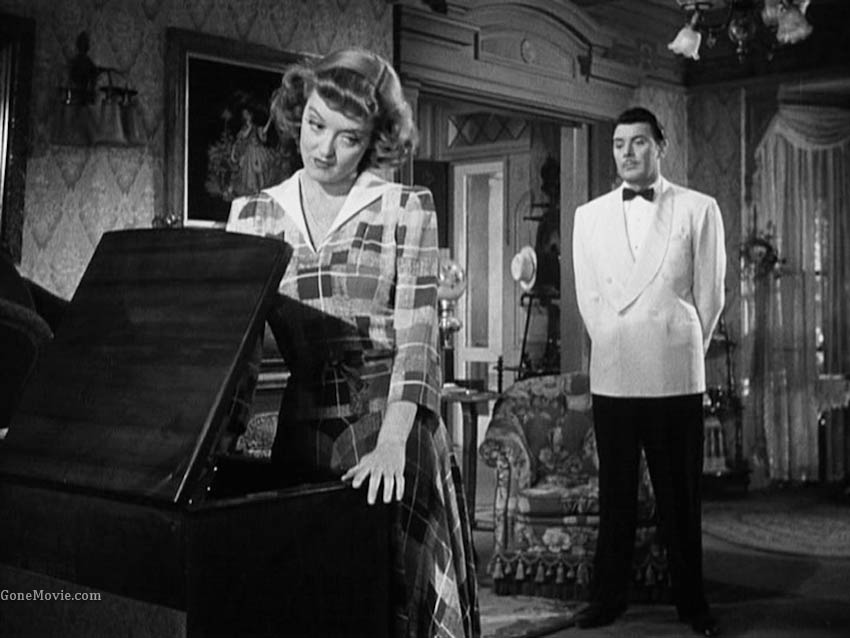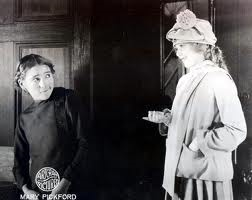All are welcome to attend our next Melodrama Meeting which will take place on the 8th of December, Jarman 7, 5-7pm. We will be discussing in depth the group’s work with the Melodrama Research Consortium. Definitions of melodrama, especially in theatre and film, will be a key focus.
Monthly Archives: November 2014
Summary of Discussion on In This Our Life
Our discussion on John Huston’s film 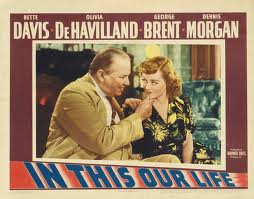 noted its focus on family. Sisters Stanley (Bette Davis) and Roy’s (Olivia de Havilland) lives are closely intertwined, partly as the former steals the latter’s husband (Dennis Morgan). In addition, the women’s father previously co-owned a business now run by their invalid mother’s (Billie Burke) brother (Charles Coburn). This is further complicated by the suspiciously close, and highly disturbing, relationship between Stanley and her uncle. Such interconnectedness comments on the American Film Institute’s (AFI’s) definition of melodrama, which notes family as an important aspect: The AFI defines melodramas as ‘fictional films that revolve around suffering protagonists victimized by situations or events related to social distinctions, family and/or sexuality, emphasizing emotion’. (http://afi.chadwyck.com/about/genre.htm)
noted its focus on family. Sisters Stanley (Bette Davis) and Roy’s (Olivia de Havilland) lives are closely intertwined, partly as the former steals the latter’s husband (Dennis Morgan). In addition, the women’s father previously co-owned a business now run by their invalid mother’s (Billie Burke) brother (Charles Coburn). This is further complicated by the suspiciously close, and highly disturbing, relationship between Stanley and her uncle. Such interconnectedness comments on the American Film Institute’s (AFI’s) definition of melodrama, which notes family as an important aspect: The AFI defines melodramas as ‘fictional films that revolve around suffering protagonists victimized by situations or events related to social distinctions, family and/or sexuality, emphasizing emotion’. (http://afi.chadwyck.com/about/genre.htm)
 Family is further emphasised were by the constant contrasting of Stanley and Roy. This was done on several levels. Personality and behaviour are of course key, but costume also plays a significant role. While Olivia de Havilland is introduced wearing a muted blue outfit (her father helpfully comments on the colour of the dress suiting her since the film is shot in black and white) Stanley is often seen in flashier outfits of prints, plaid patterns and flouncy frills. Furthermore she is criticised by other members of her family for wearing skirts which are too short.
Family is further emphasised were by the constant contrasting of Stanley and Roy. This was done on several levels. Personality and behaviour are of course key, but costume also plays a significant role. While Olivia de Havilland is introduced wearing a muted blue outfit (her father helpfully comments on the colour of the dress suiting her since the film is shot in black and white) Stanley is often seen in flashier outfits of prints, plaid patterns and flouncy frills. Furthermore she is criticised by other members of her family for wearing skirts which are too short.
Stanley and Roy’s reactions to tragedy also tellingly involve clothes. After learning that her husband has deserted her for her sister Stanley, Roy angrily asserts that ‘I’m not wearing black’ and resolves to buy a red hat with a feather. We see her wearing the accessory soon after, but the film’s black and white photography downplays the colour’s vividness. Similarly, when Stanley is supposedly heartbroken after the suicide of her husband she soon casts aside black outfits. Instead she opts for a light plaid which shocks her bed-ridden mother. The reactions of both sisters therefore involve the dismissal of black costumes. However, differences in the degree of seriousness of the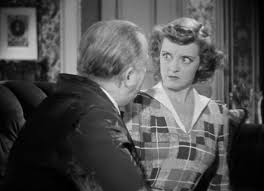 situations they are responding to is significant. While both have lost a husband (the same husband) Stanley has driven Peter to suicide. Also while Roy speaks of behaving badly to get what she wants (as Stanley always does) she does not follow though on this. Instead she does what the narrative expects – she falls in love with Stanley’s discarded fiancé, Craig (George Brent).
situations they are responding to is significant. While both have lost a husband (the same husband) Stanley has driven Peter to suicide. Also while Roy speaks of behaving badly to get what she wants (as Stanley always does) she does not follow though on this. Instead she does what the narrative expects – she falls in love with Stanley’s discarded fiancé, Craig (George Brent).
De Havilland and Davis’ acting was also markedly different. While de Havilland was not necessarily always restrained, her main outburst is the one outlined above. By contrast Davis is constantly playing at fever pitch. Davis’ performance involved variation in terms of embodying coyness, girlishness (very much denoted by Davis’ higher than usual voice), anger, seduction, deviousness etc, but there were very few, if any, moments were Davis/Stanley was completely still. Even when Davis/Stanley is sat listening to a gramophone record she is performing a dance with her shoes. It is also very noticeable that Davis’ face is never at rest. We particularly commented on Davis’ use of her eyes.
We also related Davis’s performance to her precious incarnation of Mildred in Of Human Bondage (1934, John Cromwell). (You can see our earlier discussion of this film here: http://blogs.kent.ac.uk/melodramaresearchgroup/2013/10/10/summary-of-discussion-on-of-human-bondage/) Stanley and Mildred are both irredeemable characters, devoid of any moral compass. The impact of Stanley’s selfishness is more far-reaching however. While in Of Human Bondage the main person who suffered was the film’s protagonist, Philip, in In This Our Life Stanley devastates Roy and Craig, other members of her family and significantly a young employee of colour, Parry Clay (Ernest 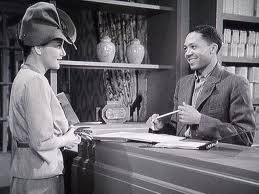 Anderson), who Stanley blames for a fatal car accident she caused while drunk. This is shown in opposition to Roy and Craig’s kind treatment of Parry. Roy works with Parry at an Interior Decorators and she finds him work at Craig’s law office (Craig is a Civil Rights lawyer) when Parry expresses his wish to train as a lawyer.
Anderson), who Stanley blames for a fatal car accident she caused while drunk. This is shown in opposition to Roy and Craig’s kind treatment of Parry. Roy works with Parry at an Interior Decorators and she finds him work at Craig’s law office (Craig is a Civil Rights lawyer) when Parry expresses his wish to train as a lawyer.
Max Steiner’s score was also discussed. This accompanies many of the film’s emotional moments and is also used to foreshadow bad news. During several telephone calls when we are only privy to one side of the conversation the film’s music heavily underscores a sense of impending doom also conveyed by dialogue and actors’ expressions.
Do, as ever, log in to comment, or email me on sp458@kent.ac.uk to add your thoughts.
Melodrama Screening and Discussion, 24th of November, Jarman 7, 5-7pm
All are very welcome to join us for the fourth of this term’s screenings, which will take place on the 24th of November, Jarman 7, 5-7pm. We will be showing In This Our Life (1942, John Huston, 97 mins).
Ann-Marie has very kindly provided the following introduction:
In This Our Life (John Huston, 1942) stars Bette Davis and proves she is best when she is being bad. Davis stars as Stanley Timberlake a woman that is never satisfied and will use any man she can to stay on top. Consumed by jealousy and greed Stanley leaves her fiancée and steals her sister’s husband! Stanley’s selfish ways spell disaster and death in every turn in this melodrama filled with tangled love affairs and seedy incestuous temptations!
Before the shooting of this film commenced Davis’ husband, Farney, had become seriously ill. Despite the studio’s request to stay for costume fittings Davis flew to Minneapolis to see her husband. On her journey Davis had been told by a studio representative that her husband was recovering, but Bette knew better. Once she arrived at Minneapolis her husband was in intensive care and she was furious at Jack Warner for lying to her. Soon her husband became better and told Davis to return to L.A. However, a mix of worry and anger did not leave Davis, and it has been suggested by James Spada that her performance has a ‘fevered manner’ (Spada, 1993, p. 259) due to her ‘frazzled state’ (p. 259). Bette is let loose in this film to stomp and twitch wildly, perhaps the most in any of her films to date. After all, it is this film that claimed: ‘Nobody’s as good as Bette when she’s bad!’
Do join us, if you can, for all the above!
Melodrama Screening and Discussion, 10th of November, Jarman 7, 5-7pm
Posted by Sarah
All are very welcome to join us for the third of this term’s screenings, which will take place on the 10th of November, Jarman 7, 5-7pm. We will be showing Stella Maris (1918, Marshall Neilan, 84 mins).
Neilan’s film focuses on the two women pictured above: the title character and her inverted mirror image, both of whom are played by Mary Pickford. Stella Maris is a young, paralysed woman who has deliberately been kept ignorant of the suffering people are capable of inflicting on one another. By contrast, Unity Blake is a young orphan who is severely beaten by her violent alcoholic female employer. The pair are brought together by their mutual love for one man – John Risca (Conway Tearle) – and Unity sacrifices her life for Stella and John’s happiness.
The melodramatic plot outlined above should provide much for us to discuss, while the doubling of Pickford as both characters links closely to the Gothic tradition, discussed earlier this year in relation to Black Swan (2010).
Do join us, if you can, for one of Pickford’s finest films.
Melodrama Research Consortium Discussion on the 8th of December, Jarman 7, 5-7 pm
Posted by Sarah
Following last week’s fruitful discussion on melodrama definitions and The Melodrama Research Consortium we have decided to use our session on 8th of December to take this further. We will therefore not be screening The Best Of Everything (1959) this term. Apologies for any disappointment caused.

